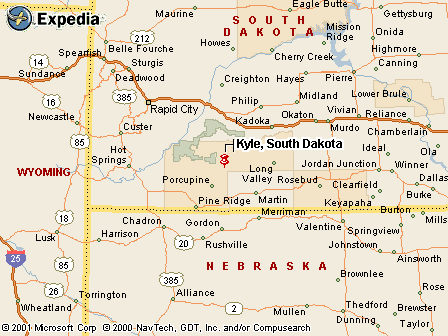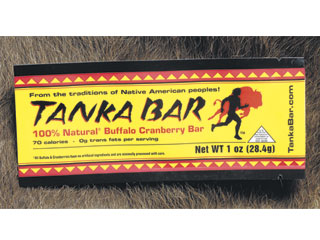 |
Canku Ota
|
 |
|
(Many Paths)
|
||
|
An Online Newsletter
Celebrating Native America
|
||
|
April 1, 2009 - Volume
7 Number 4
|
||
|
|
||
|
Tanka Bars Blend
Traditional Nutrition With 21st Century Marketing Savvy
|
||
|
by Gale Courey Toensing
for Indian Country Today
|
||
|
After barely a year-and-a-quarter on the market, the Tanka Bar has been named Editor’s Choice by Gourmet Retailer, the premier gourmet and specialty food trade magazine. “I believe Tanka Bars are destined to become the next great energy bar/snack food,” Gourmet Retailer Editor James Mellgren wrote in the Jan. 1, 2008 edition. Being selected as Editor’s Choice in the 20-year-old magazine that is distributed nationally to almost all of the gourmet and specialty foods retailers in the country will likely help fulfill that prediction. “As a new food company, it’s great to get this kind of recognition from the food industry,” said Mark Tilsen, president and co-founder with CEO Karlene Hunter of Native American Natural Foods, a Native-owned company based in Kyle, S.D. on the Pine Ridge Reservation. The Tanka Bar is an all natural buffalo and cranberry energy bar that was launched in October 2007. Last year, the company sold half a million Tanka Bars. It expects to double that amount this year and extend its line of healthy, traditional food products, Tilsen said. Tilsen,
whose children are enrolled members of the tribe, and Hunter, a
member of the Oglala Sioux Tribe, have been business partners for
years, and in 1996 co-founded Lakota Express, a direct marketing
and customer care management company focused primarily on fund raising
for nonprofit As
business partners the two provided more than $1 million a year for
projects on Pine Ridge for 20 years according to them, but the partners
were looking for “We’ve employed people for a long time. We have a 7,000-square-foot call and distribution center but there was a lot of ebb and flow in our business. We worked with government, major corporations and those projects always come and go and we started studying how we could develop a brand or product where the raw materials were coming from the community and the community itself was really marketing it, to really look at how wealth is created in a modern environment and how we could build a company that was sort of along the lines of a Ben and Jerry’s, a highly environmentally responsible company that would really impact society in a positive way,” Tilsen said. Tilsen and Hunter spent years researching and probing ideas across the country and by engaging young people on MySpace. “When you look at Pine Ridge, like a lot of Indian communities, there are some really serious health problems and along with economic problems, this really outrageous diabetes rate that impacts over 50 percent of the adult population. So, we thought, what if we try to take the concept of traditional food but repackage it in a healthy way but also make it a consumer level product to try to impact young people’s eating habits,” Tilsen said. There are few things more traditional than wasna, the product of the ancient indigenous method of preserving meat by pounding it into a paste and mixing it with berries whose acidic content served as a preservative. The Lakota people used buffalo meat and packed their wasna in kidney fat, the richest fat on the buffalo. “Wasna was actually one of the first foods ever exported from this country. Indian people sold wasna to the Hudson Bay Company in the 1800s and it was sold to the cavalry in some places. It gave warriors or hunters the ability to carry enough food for long periods of time that was very healthy, packed in buffalo kidney fat. When we looked at producing the Tanka Bar we looked at the same process, but we removed the fat, of course, added the modern packaging that fits with USDA and FDA and is in compliance. Our goal was not to preserve as many calories as possible but provide a healthy, sustainable, great tasting product,” Tilsen said. He said it was important to engage the community at every level from purchasing the raw ingredients locally to hiring employees and providing other benefits. One of the first investments into the new company came from the Lakota Fund, a program of the federal Community Development Financial Institute. “It was the first Native American-based CDFI in the country, so the community actually owns five percent of this company,” Tilsen said. The Tanka Bar has five ingredients. The one-ounce Tanka – which means “outstanding” or “great” – has 1.5 grams of fat, 7 grams of carbohydrates, and packs an impressive seven grams of protein – all in 70 calories. The bars have an engaging slightly chewy texture and a unique combination of meaty, sweet and salty taste. “Tanka Bar is a new nutrition bar built on our ancestors’ knowledge of the ideal portable energy for endurance and top performance helping us run far, work hard or dance all night with joy and appreciation,” the product information packet says. The Tanka Bar has been remarkably successful in its short time in the market. The bar is now in more than 2,000 locations and about 20 tribes have incorporated it into their diabetes prevention programs. “We try to work with as many tribes as possible as we try to grow our company, and get more tribes to look at our company as a source of high quality, healthy, great tasting products that represent the very best of what Indian country has to offer to incorporate into their health programs in schools, and business enterprises and even into their gaming establishments,” Tilsen said. The company will soon be launching Tanka Bites, a smaller version of the Tanka bar, and Tanka Wild, a summer sausage made of buffalo, cranberry and wild rice. The company is also engaged in efforts to market the Tanka Bar to the trendy Whole Foods chain of supermarkets. “We’ve made progress there. I would safely predict if you were to interview me in a year, we’ll be in Whole Foods,” Tilsen said. |
 Kyle, South Dakota map |
www.expedia.com |
|
|
||
|
|
||
| Canku Ota is a free Newsletter celebrating Native America, its traditions and accomplishments . We do not provide subscriber or visitor names to anyone. Some articles presented in Canku Ota may contain copyright material. We have received appropriate permissions for republishing any articles. Material appearing here is distributed without profit or monetary gain to those who have expressed an interest. This is in accordance with Title 17 U.S.C. Section 107. | ||
|
Canku Ota is a copyright ©
2000, 2001, 2002, 2003, 2004, 2005, 2006, 2007, 2008, 2009 of Vicki
Barry and Paul Barry.
|
||
 |
 |
|
|
The "Canku
Ota - A Newsletter Celebrating Native America" web site and
its design is the
|
||
|
Copyright ©
1999, 2000, 2001, 2002, 2003, 2004, 2005,
2006, 2007, 2008 of Paul C.
Barry.
|
||
|
All Rights Reserved.
|
||
 KYLE,
S.D. – The Tanka Bar may not be a universally recognized brand
name, but it’s well on its way to becoming one.
KYLE,
S.D. – The Tanka Bar may not be a universally recognized brand
name, but it’s well on its way to becoming one.